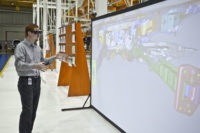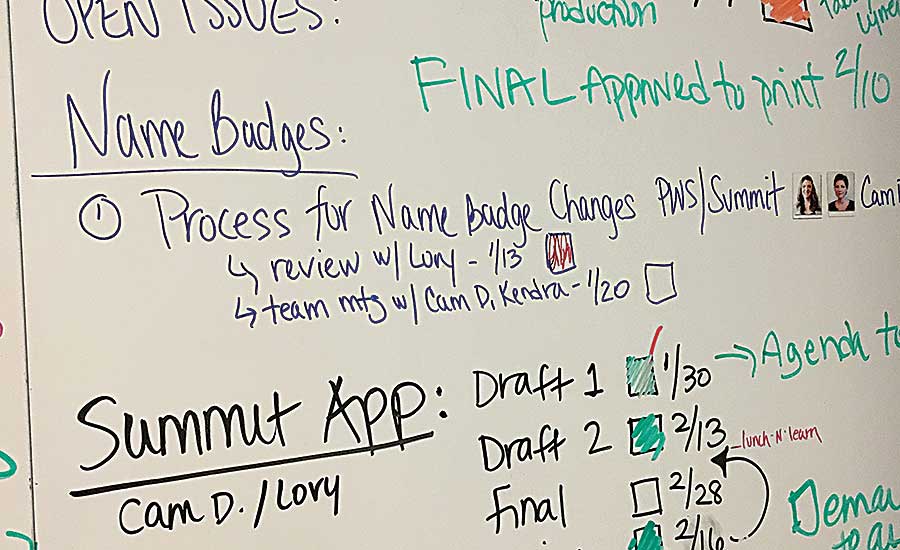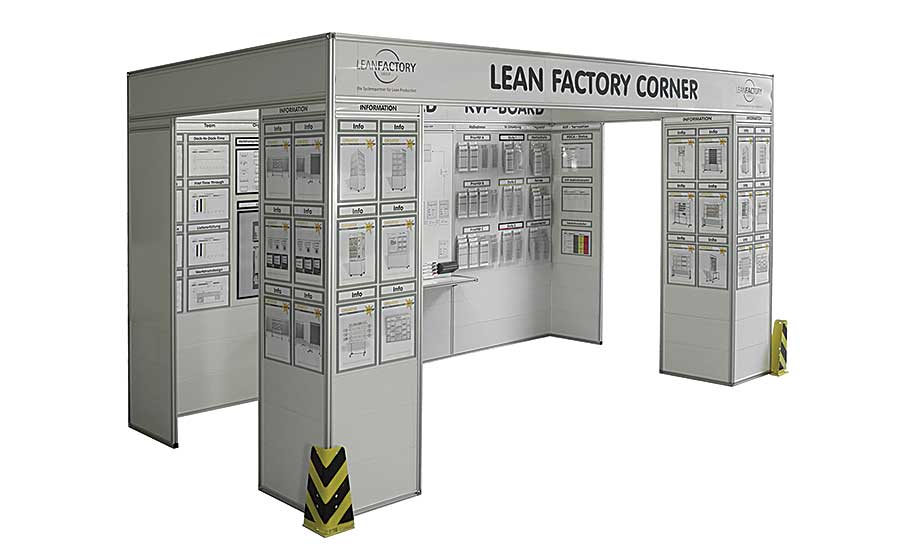Make Room for Obeya
Visual communication areas can be powerful production tools.

Manufacturers use obeyas to improve productivity, address quality issues and implement continuous improvement initiatives. Photo courtesy Toyota Industrial Equipment Manufacturing Inc.

This section of an obeya room shows activities, pictures of responsible associates, and the status of due dates in green or red, so that people can focus immediately on abnormalities. Photo courtesy Lean Enterprise Institute Inc.

Digital obeyas enable multisite collaboration by unshackling traditional paper-based constraints. Photo courtesy iObeya

This custom-built obeya consists of multiple magnetic, dryerase panels. Photo courtesy Lean Factory America LLC

Obeya rooms typically contain boards that are both magnetic and can be written on. Photo courtesy Graphic Products





"War room.” The phrase conjures up images of generals standing around a table-sized map, plotting their next move. However, a growing number of manufacturers have begun instituting war rooms of their own.
Known as obeyas, these areas aren’t used for planning hostilities. Rather, they’re used to facilitate problem-solving. Manufacturers such as Boeing and Toyota use obeyas to improve productivity, address quality issues and implement continuous improvement initiatives.
The concept revolves around using visual communication tools, such as charts, graphs, laminated cards, magnets, sticky notes and wipe-off boards, to give project managers or assembly line managers responsible for daily results a big picture of what’s happening. It allows them to focus on team efforts and coordinate actions.
An obeya helps break down the barriers that prevent employees from communicating and sharing information. Ideally, it encourages employees to pool their collective expertise and resources to make the best possible decisions.
Traditionally, an obeya (also spelled “oobeya”) was confined to an enclosed space hidden within a plant. But, some manufacturers are now expanding the concept and implementing it on their production floors.
Obeya Defined
The term “obeya” can be interpreted different ways, but it should deliver similar results: better collaboration.
“The direct translation in Japanese is simply “big room,” says Art Smalley, president of the Art of Lean Inc., and a former engineer at Toyota Motor Corp. “It implies a dedicated space for a specific problem where a group of team members will regularly meet to work on a specific topic for a given period of time. It involves work that is above and beyond the ordinary realm.
“Just having a big room for regular meetings was not really the original intent,” explains Smalley. “The room should have a purpose and a goal that involves work that’s beyond just regular work.”
Smalley says numerous examples of obeyas exist outside of manufacturing. “There are many analogous examples for this style of meeting room,” he points out. “Think of a mission control room at NASA, a dedicated prep room for the NFL draft, hostage crisis situations, or other instances where time and space is dedicated for a particular objective.
“These are not the exact same as an obeya at a Toyota factory,” says Smalley. “However, there are similarities in terms of concept.”
There are no requirements or set rules for an obeya. Four walls and open space are all that’s required. Where there are no physical walls, then white boards can substitute.
But, to be successful, an obeya requires more than just walls.
“Practically speaking, it is a place, a process and a purpose,” says Jamie Flinchbaugh, a lean manufacturing consultant who has worked with hundreds of companies, including BMW, Chrysler and Harley-Davidson. “The place should be large enough for people, information and decisions to all mix.
“The process must make information visible with a high cadence of collaboration that is both defined by planned meetings and informal conversations,” adds Flinchbaugh. “The purpose is to improve collaboration, alignment and speed of problem solving.”
As a management concept, obeya refers to a big room that is shared by people who work as a team. They collaborate on the work, communicate face to face and post information about the work on the walls for everyone to see. To be effective, an obeya should be a no-distraction zone that encourages people to stand rather than sit.
“At Toyota, an obeya is a room where projects are made visible so the cross-functional team of people interacting on a project can visibly track progress,” says Mark Reich, who formerly served as general manager of the Toyota Production System Support Center Inc., a division of Toyota Motor Engineering & Manufacturing North America Inc. that works with small manufacturers, government agencies, hospitals and other organizations. “But, it doesn’t have to be a room.
“If you go to a group leader’s area at a Toyota assembly plant, it will be an area like an obeya with a visual board tracking attendance, the previous day’s output, quality metrics, machine uptime and other key performance indicators,” notes Reich, who currently serves as chief operating officer at the Lean Enterprise Institute Inc. (LEI).
“The obeya meeting, so to speak, happens first thing in the morning when team members and group leader review how they did yesterday, what’s the plan for today, and what kind of problems they might encounter,” explains Reich. “They’ll review that information at least daily, maybe hourly, depending on how the line is performing.
“The key is not to get stuck on [the misnomer] that it has to be a room,” warns Reich. “It’s a place where teams can come together, understand the current state and [solve problems] that are in the way of achieving some defined future state.”
Multiple Flavors
An obeya can be a short-term area set up for the duration of a specific project. Or, it can be used permanently for daily meetings and updates.
“Setting up a room is easy; implementing the management discipline of using it as an obeya is hard,” claims Michel Baudin, a partner at the Takt Times Group and the author of Lean Assembly. “And, the number of people in an obeya should be just large enough for them to work as a team. It should be more than two, but less than 20. As is well known, from a group dynamics perspective, six to eight people is ideal.”
According to Baudin, the obeya should be as close as possible to the object of the team’s work. “If it is a production line, the obeya should be next to it, not a 15-minute walk away,” he points out. “If it is product development, the obeya should be in the lab where all the resources are available for prototyping and experimentation.
“That means you shouldn’t try to have a row of obeyas in one section of your plant,” says Baudin. “Instead, rooms that can be used as obeyas need to be sprinkled throughout.”
Obeyas come in many shapes, sizes and configurations. In fact, some manufacturers refer to them by different names, such as glass houses or zero-defect rooms.
“Form follows function,” says Smalley. “There is no one type of obeya inside of Toyota or other companies that utilize the concept.
“A problem-solving obeya would focus on a specific major problem and follow the flow of a problem-solving methodology,” explains Smalley. “On the other hand, a project obeya would follow the phases of a given project and reflect the flow of work, assignments, reviews and progress reports.”
The obeya concept traces its roots back to when Toyota was developing its Prius hybrid sedan in the early 1990s.
“It was developed to reduce time to market from 36 to 18 months,” says Craig Flynn, CEO and managing director of QV System Inc., a consulting company that specializes in product development applications. “Its visual elements and behavioral elements (kata) were drawn from daily stand-up meetings on the factory floor.”
“A product-focused obeya with a cost-reduction emphasis was common when I worked for Toyota in Japan,” adds Smalley. “Selected components were torn down, analyzed and compared to competitor offerings. Ideas for improvement were created, analyzed, evaluated and implemented during the life of the obeya.
“Today, there are very few instances of a true obeya inside of Toyota’s factories,” Smalley points out. “Visitors and consultants seem to visit Toyota and view any open office spaces, large training rooms, daily operational meeting rooms or team problem solving areas and generically call them all an ‘obeya.’
“Sometimes, they are big rooms,” Smalley points out. “However, those examples are usually just open spaces with visual charts and set meeting routines for what we’d internally consider normal work.
“Historically, an obeya is a very unique room for a special purpose for irregular work or a particular challenge that is really above and beyond the ordinary for a dedicated period of time,” notes Smalley. “The most common ones I observed [at Toyota] were related to product launches and specific quality improvement or cost-reduction initiatives. In other words, the room went away once the objective was achieved.
“I hear the term ‘obeya’ a lot more these days, and it seems to have some appeal to organizations attempting to implement lean concepts,” says Smalley. “To some extent, I suspect it is just a buzzword or new fad to try out.
“In some instances, however, it probably fulfills a need or gap that existed for some reason,” explains Smalley. “I see lots of daily meeting rooms in various companies referred to as an ‘obeya.’”
As more manufacturers learn about the benefits of obeya, the concept is slowly evolving.
“We see it becoming more popular as companies turn to lean manufacturing for improving efficiency,” says Matt Wastradowski, a lean manufacturing expert at Graphic Products, a company that supplies GM, Toyota and other firms with visual communication products. “Obeyas are an appealing choice because of the emphasis on visual communication, the singular focus on solving specific problems and the inclusive decision-making process.”
Traditionally, manufacturers had to rely on paper-based charts and graphs. But, the newest trend is a virtual obeya that enables teams of people in different locations to collaborate online.
Six years ago, a French software company called KAP IT developed a digital obeya platform for auto manufacturer PSA Group. It launched a commercial version of the product, called iObeya, in 2012.
“You don’t need to dedicate rooms or walls for visual management collaboration activities,” says Zal Pezhman, general manager of iObeya. “Our system enables multisite collaboration, which appeals to big, lean organizations. People can interact any time, any place.
“It unshackles traditional paper-based constraints,” adds Pezhman. “We provide a solution that looks, feels and behaves as close as possible to paper. The system operates on large-format interactive displays and touch screens.”
In addition to PSA, other manufacturers that use iObeya include Airbus, Continental, Faurecia, Renault and Volvo. It’s also used by Wahl Clipper Corp., an American manufacturer of hair clippers and trimmers.
Obeya in Action
Toyota Industrial Equipment Manufacturing Inc. (TIEM), a leading manufacturer of forklifts that operates a state-of-the-art assembly plant in Columbus, IN, has a designated area that it refers to as the “adrenaline room.”
“Each of our team leaders gathers information and maintains a control board in their area on the shop floor or in the office,” says Tom Lego, customer center manager at TIEM. “Many of these daily metrics are rolled up from these boards to this room.
“We have changed the process many times over the years,” explains Lego. “But, the most important lesson that we have learned is that regardless of the amount of data that you gather and place on the walls, nothing happens until someone is willing to do something or act upon this data.
“The idea of calling this an ‘adrenaline’ room was our way of challenging us to go beyond reporting what happened and make a commitment to move forward with our next activity based upon the data that has been gathered and shared with the team,” Lego points out. “By getting this team together, we hold each other accountable—not only for driving continuous improvement, but assuring that we are working toward these objectives in alignment with our Toyota core values.
“While the executive staff attends the meetings, they do so in more of an advisory role,” adds Lego. “They are there to offer suggestions and guidance, but their desire is to help build a management team that works together to take ownership of the current condition.”
Although TIEM’s room is equipped with digital technology, such as flat screens, most of the work is done on white boards or hand-drawn charts and graphs.
“There are no extra ‘style points’ for your presentation,” says Lego. “The objective is to continue to use the data to help drive improvements.
“We will gather some of the major indices from time to time for database information and overall trend analysis, but most of the daily reports are hand-written and colored with markers and colored pencils,” explains Lego. “If we take time to color in a chart, we are also creating additional reflection time prior to explaining our observations and action plans to each other.
“We use many lean tools, such as PDCA (Plan-Do-Check-Act), but often we use 5 Why analysis and weak point management as the major problem-solving methods,” says Lego. “But, regardless of the lean manufacturing tools that we use, we believe that being on the shop floor, actively supporting all associates, allows us to better understand the real condition and [implement] improved collaborative efforts to drive continuous improvement.”
The ultimate goal of the adrenaline room is to help TIEM improve productivity and address its continuous improvement goals.
“By reflecting and acting upon data on a daily basis, we have an improved opportunity to make an improvement while there is still good ‘evidence’ in the process,” Lego points out. “Often, if we do not investigate and actively use the data gathered, we have found that it is of little value when we finally set out to make an improvement.”
Setting Up an Obeya
An obeya room can be as simple as a wall or as elaborate as a free-standing structure. Some are enclosed with a roof and walls to allow better communication over the din of the factory floor, while others implement sound systems to allow all to hear.
“Constructing the rooms out of structural aluminum framing allows modularity and lighter weight in the event of relocation,” says Kurt Greissinger, vice president of Lean Factory America LLC, which markets a variety of visual management products, such as magnetic three-ring binders and sheet protectors that attach to boards. “Putting the room on casters facilitates ease of relocation around the plant.”
Lean Factory America is the U.S. distributor for Orgatex GmbH, a German company that produces items such as rotating cubes and a freestanding unit called the lean factory corner. It consists of walls made out of a magnetic, dry-erase porcelain ceramic-coated steel. The top half features double-sided magnetic whiteboards, while the bottom portion is comprised of white composite panels.
“The panels allow the use of adhesive or magnetic accessories for holding documents, markers and erasers,” notes Greissinger, who says professionally built obeyas are becoming more popular today.
“In the past, many companies built their own internally, along with their own accessories for it,” he points out. “Advances have been made and companies like ours exist to supply such structures and products. The result is a more professional-looking obeya that will last for years to come.”
An obeya should get employees out of their offices or cubicles and into a central location where they can meet, discuss key information and solve pressing problems. Whether it’s an empty office with four walls, or an unused spot on the plant floor that can accommodate boards and panels, the area should provide enough room so that people can plan, discuss and work together.
“First, the team has to identify the purpose of the obeya,” says LEI’s Reich. “Part of the purpose will always be visual management. [The goal is] to make information visible that lives in computers and people’s heads. But, just putting information on a wall doesn’t make it valuable. The [second] purpose of an obeya is collaborative problem solving.
“Another important purpose of an obeya is abnormality management,” adds Reich. “You want to have critical data visible, so when you walk into a room, it’s clear what is a problem and what isn’t a problem. You don’t want to spend time figuring out what the problem is. You want to see what are the planned vs. actual results immediately, usually by color-coding metrics green, yellow or red.”
According to QV Systems’ Flynn, an obeya should include three basic elements: a visual board containing goals, targets and metrics; an action board; and an issue board for problem-solving and decision-making.
Obeyas should also be well stocked with markers, flip charts, magnetic windows or sheet protectors, and other visual tricks of the trade.
“Having the right accessories [on hand] helps facilitate the process,” says Lean Factory America’s Greissinger. “The act of filling in a graph by hand or changing the status from one color to another is much more meaningful when you see and feel the change.”
Looking for a reprint of this article?
From high-res PDFs to custom plaques, order your copy today!












